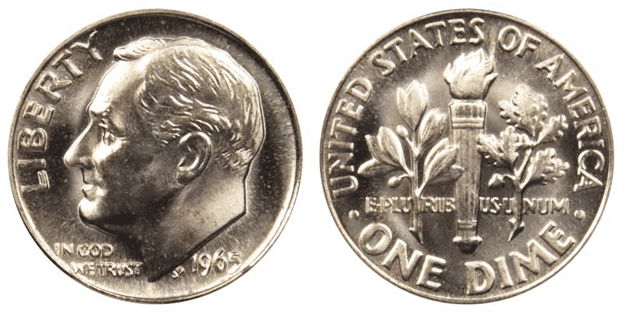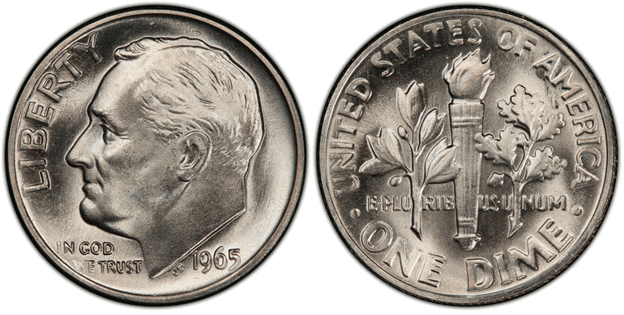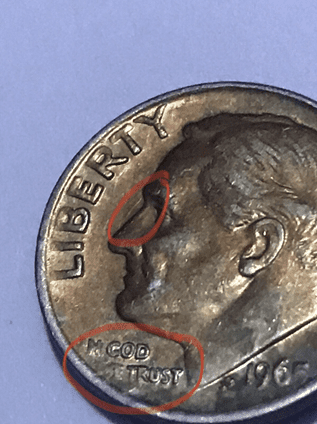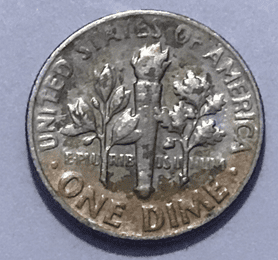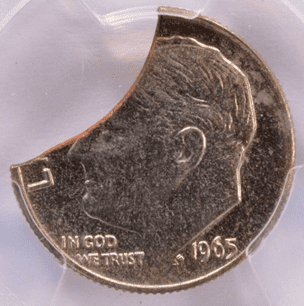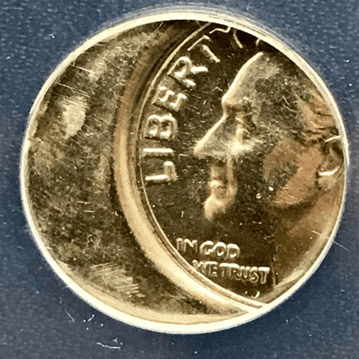What Is the 1965 Roosevelt Dime Made Of?
The 1965 Roosevelt dime is composed of 75% copper and 25% nickel. The core is made of copper while its surface is a mixture of copper and nickel.
To give you more idea, here are the specifications of the 1965 Roosevelt dime:
- Value – 10 cents
- Diameter – 17.91 mm
- Mass – 2.268 g
- Edge – reeded
While the 1965 Roosevelt dime is made of copper and nickel, in 1992 to 2018, the dime was made of silver as a collectors’ version. These silver dimes weren’t made for circulation.
The 1965 dime was designed by john Sinnock. Sinnock needed to modify his design repeatedly until he met all the requirements of the Commission of Fine Arts.

photo source: USA Coin Book
The obverse features of the left profile of Theodore Roosevelt. The inscriptions include the following:
- LIBERTY
- IN GOD WE TRUST
- 1965
- Designer’s initials (JS)
On the reverse side, you’ll find images of an olive branch, which represents peace and an oak branch, which represents independence and strength. In the center is the liberty torch.
The inscriptions include the following:
- UNITED STATES oF AMERICA
- E PLURIBUS UNUM
- ONE DIME
1965 is the first year when the U.S. Mint removed all silver composition from the Roosevelt dime. One reason is that people don’t spend the dime as much as they should. Some people would rather keep them as a part of their coin collection.
Aside from that, the main reason why the U.S. Mint stopped striking the silver dime was that silver is getting more and more expensive to the point that the face value of the dime is lower than the raw material it is made of.
As a result, in 1965, the U.S. Mint decided to use cheaper base metals, which include copper and nickel. Although US Mint started to produce the cupronickel dime in 1965, the Roosevelt dime has been in circulation since 1946.
When Roosevelt died in 1945, the US Mint moved immediately to honor the beloved president by adding him to the dime. The Roosevelt dime replaced the Mercury dime in 1945.
1965 Roosevelt Dime Varieties
Because 1965 is the first year when the US Mint stopped using silver, there’s only one official variety of the 1965 Roosevelt dime. This is the 1965-P Roosevelt dime that doesn’t have a mint mark.
Year of minting: 1965
Mint Mark: None
Place of minting: Philadelphia
Quantity produced: 1,652,140,570
Face Value: $0.10 (one cent)
Price: $0.10 to $2.81 (or more)
Mass: 2.268 grams
Edge: Reeded
Designer: John Sinnock
Composition: 75% copper and 25% nickel
Diameter: 17.91 mm
Thickness: 1.35 mm

photo source: PCGS
The 1965-P with no mint mark dime can be sold for up to $2.81. Although 1965 is the first year when the dime was made with base metal, some people reported that there might still be some 1965 dimes that are made of silver.
List Of 1965 Roosevelt Dime Errors
The Philadelphia Mint produced more than 1.6 billion of the 1965 Roosevelt dime coins. As you can imagine, there’s always a chance that coins made in bulk could be made with errors.
There are different types of errors and it would highly depend on what caused them. Errors can be caused by humans or minting equipment. For example, because of the repeated motion and strike, the die could wear out, which can cause a die break. When the die breaks, cracks may develop and these cracks can be seen on the coin.
Here’s an example of a die break error on a 1965 Roosevelt dime:

photo source: eBay
There’s also a chance that the dime was improperly annealed as shown here:

photo source: eBay
There are times that errors happen during the cutting of planchets. Sometimes, the planchets weren’t perfectly shaped like circles. Some parts are clipped or folded. Here’s an example of a 1965 dime with a clipped portion:

photo source: eBay
When the die strikes the planchet, it should be perfectly aligned. However, due to mechanical failure, the die didn’t hit the center of the coin. It could be because the coin wasn’t properly held in place or the die didn’t just hit the coin at the right time.
Here’s an example of an off-center 1965 dime:

photo source: eBay
Now, there are more coin errors that affected the 1965 dime. Thankfully, they rarely occur. However, for most coin collectors, coin errors are actually what they like because of their uniqueness. So, even if coin errors are something the US Mint doesn’t want to happen, it’s still a treasure for coin enthusiasts.
How Much Is 1965 Roosevelt Dime Worth Today?
The face value of the 1965 Roosevelt dime is only 10 cents. Its melt value is $0.02. As you can see, 1965 dimes aren’t that valuable if you’re just going to look at their face value and melt value.
Nevertheless, there are still 1965 Roosevelt dimes that are worth a lot of money. Here’s a 1965 Roosevelt Dime values chart to help you get an overview:
| Coin | Condition | Grade | Mintage | Value |
| 1965 no mint mark Lincoln penny | Circulated/mint | Not graded | 1,652,140,570 | $0.10 to $2.81 |
| 1965 no mint mark Lincoln penny | Uncirculated/mint | MS-64 | 1,652,140,570 | $5 |
| 1965 no mint mark Lincoln penny | Uncirculated/mint | MS-65 | 1,652,140,570 | $45 |
| 1965 no mint mark Lincoln penny | Uncirculated/mint | MS-66 | 1,652,140,570 | $87 to $240 |
| 1965 no mint mark Lincoln penny | Uncirculated/mint | MS-67 | 1,652,140,570 | $306 to $805 |
As you can see, even if the face value of the dime is only 10 cents, if it is still in good condition and rare, it can be sold for hundreds of dollars.
How Does The Grading System Work?
The Sheldon Scale is used by numismatists to provide a numerical value to coins. The Sheldon Scale goes from poor (P-1) to perfect mint state (P-1) (MS-70). Coins were originally evaluated using words to reflect their condition (Good, Fair, Excellent, Etc.). Unfortunately, coin collectors and dealers had different ideas about what each of these terms represent.
Professional numismatists joined together in the 1970s and established CoinGrading standards. These numismatists now assign grades at key places on the seventy-point scale, using the most regularly utilized numeric points in conjunction with the original adjective grade. The following are the most common coin grades:
-
-
- (P-1) Poor – Indistinguishable and probably damaged; if used, must have a date and mintmark; otherwise, rather battered.
- (FR-2) Fair – Nearly smooth, but without the damage that a coin graded Poor often possesses. The coin must have enough detail to be identified.
- (G-4) Fair – Inscriptions have merged into the rims in some areas, and important elements have been mostly erased.
- (VG-8) Very Good- A little weathered, but all of the primary design elements are visible, albeit faintly. There is little if any, central detail left.
- (F-12) Good – The item is very worn, yet the wear is even, and the overall design details stand out clearly. Rims are almost completely isolated from the field.
- (VF-20) Very Fine – Moderately weathered, with some finer features still visible. The motto or all letters of LIBERTY are readable. Both sides of the coin have entire rims that are separated from the field.
- (EF-40) Extremely Fine – Gently used; all gadgets are visible, and the most important ones are bold. The finer details are bold and clear, however, light wear may be seen.
- (AU-50) Uncirculated – Slight evidence of wear on the coin’s design’s high points; may have contact marks; eye appeal should be adequate.
- (AU-58) Uncirculated Choice – Slight traces of wear, no severe contact marks, almost full mint shine, and great eye appeal.
- (MS-60) Mint State Basal – Strictly uncirculated; no indication of wear on the coin’s highest points, but an unsightly coin with reduced luster, visible contact marks, hairlines, and other flaws.
- (MS-63) Mint State Acceptable – Uncirculated, but with contact scratches and nicks, little reduced shine, but otherwise appealing appearance. The strike is weak to average.
- (MS-65) Mint State Choice – Uncirculated with great mint shine, very little contact blemishes, and exceptional eye appeal. The strike is unusually severe.
- (MS-68) Mint State Premium Quality – Uncirculated with superb luster, no obvious contact marks to the naked eye, and exceptional eye appeal. The strike is quick and appealing.
- (MS-69) Almost Perfect Mint State – Uncirculated with perfect brilliance, a sharp and appealing strike, and extremely good eye appeal. A near-perfect coin with minor imperfections in the planchet, strike, and contact markings (seen only under 8x magnification).
- (MS-70) Mint State Perfect – Under 8x magnification, there are no tiny imperfections discernible; the strike is crisp, and the coin is perfectly centered on a beautiful planchet. Rarely seen on a coin, this coin is bright and whole, with original luster and exceptional eye appeal.
-
Are There Any Rare 1965 Roosevelt Dime?
Perhaps, the rarest 1965 Roosevelt dime is the silver version. According to some collectors, 1965 is the year when the US Mint switched from using silver to base metals. However, some of the silver planchets end up in the minting process.
Unknowingly at that time, the 1965 Roosevelt dimes that were supposed to be struck on copper and nickel were struck on silver planchets.
This is a rare occurrence. Thus, if you find a silver 1965 Roosevelt dime, you might be able to sell it for several thousand dollars.
Where To Buy Or Sell 1965 Roosevelt Dime?
You can buy a 1965 Roosevelt dime online and in local shops. If you wish to find dimes online, you can just do a Google search. You will get tens of helpful results.
To give you a headstart, you can go to Amazon, eBay, and Etsy. These online marketplaces allow you to both buy and sell 1965 Roosevelt coins.
Aside from that, there are websites that specialized in selling and buying coins. You can find them on the Internet by simply doing a search.
Aside from the Internet, you can visit coin and antique shops. You can get in touch with coin collectors as well. If you can, join their clubs or groups. The more people you know, the more chances you’ll have to find the right place to buy or sell 1965 dimes.
FAQs
Is the 1965 dime worth $2 million?
No records show that a 1965 dime was bought for $2 million or anywhere near that. However, there was one type of dime that was sold for $1,997,500 in 2016 to an anonymous buyer. This dime was known as the 1894-S Barber Dime.
Where can I find the 1965 dime mint mark?
The 1965 dime doesn’t have a mint mark. In 1965, it was the Philadelphia Mint that produced more than a billion 10-cent coins. This mint traditionally doesn’t add a mint mark on the coins it produced.
Who was the person on the 1965 dime?
The person on the 1965 dime is Theodore Roosevelt. He was the 26th president of the United States. Because of his contribution to the country, he was honored by having him on the 10-cent coin.
Do silver varieties exist in the 1965 Dime?
Yes, there were reports that silver 1965 dimes exist. Some were even already sold in auctions. The US Mint accidentally used old silver planchets when producing 1965 dimes that were supposed to be struck on base metals.

